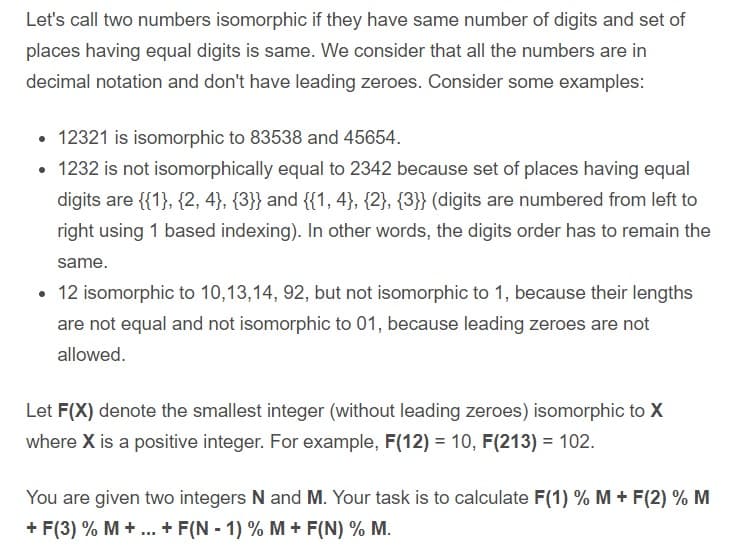please solve this asap thank you for the help
Computer Networking: A Top-Down Approach (7th Edition)
7th Edition
ISBN:9780133594140
Author:James Kurose, Keith Ross
Publisher:James Kurose, Keith Ross
Chapter1: Computer Networks And The Internet
Section: Chapter Questions
Problem R1RQ: What is the difference between a host and an end system? List several different types of end...
Related questions
Question
100%
please solve this asap thank you for the help

Transcribed Image Text:Let's call two numbers isomorphic if they have same number of digits and set of
places having equal digits is same. We consider that all the numbers are in
decimal notation and don't have leading zeroes. Consider some examples:
• 12321 is isomorphic to 83538 and 45654.
• 1232 is not isomorphically equal to 2342 because set of places having equal
digits are {{1}, {2, 4}, {3}} and {{1, 4}, {2}, {3}} (digits are numbered from left to
right using 1 based indexing). In other words, the digits order has to remain the
same.
• 12 isomorphic to 10,13,14, 92, but not isomorphic to 1, because their lengths
are not equal and not isomorphic to 01, because leading zeroes are not
allowed.
Let F(X) denote the smallest integer (without leading zeroes) isomorphic to X
where X is a positive integer. For example, F(12) = 10, F(213) = 102.
You are given two integers N and M. Your task is to calculate F(1) % M + F(2) % M
+ F(3) % M + ... + F(N - 1) % M + F(N) % M.
Expert Solution
This question has been solved!
Explore an expertly crafted, step-by-step solution for a thorough understanding of key concepts.
Step by step
Solved in 2 steps with 1 images

Recommended textbooks for you

Computer Networking: A Top-Down Approach (7th Edi…
Computer Engineering
ISBN:
9780133594140
Author:
James Kurose, Keith Ross
Publisher:
PEARSON

Computer Organization and Design MIPS Edition, Fi…
Computer Engineering
ISBN:
9780124077263
Author:
David A. Patterson, John L. Hennessy
Publisher:
Elsevier Science

Network+ Guide to Networks (MindTap Course List)
Computer Engineering
ISBN:
9781337569330
Author:
Jill West, Tamara Dean, Jean Andrews
Publisher:
Cengage Learning

Computer Networking: A Top-Down Approach (7th Edi…
Computer Engineering
ISBN:
9780133594140
Author:
James Kurose, Keith Ross
Publisher:
PEARSON

Computer Organization and Design MIPS Edition, Fi…
Computer Engineering
ISBN:
9780124077263
Author:
David A. Patterson, John L. Hennessy
Publisher:
Elsevier Science

Network+ Guide to Networks (MindTap Course List)
Computer Engineering
ISBN:
9781337569330
Author:
Jill West, Tamara Dean, Jean Andrews
Publisher:
Cengage Learning

Concepts of Database Management
Computer Engineering
ISBN:
9781337093422
Author:
Joy L. Starks, Philip J. Pratt, Mary Z. Last
Publisher:
Cengage Learning

Prelude to Programming
Computer Engineering
ISBN:
9780133750423
Author:
VENIT, Stewart
Publisher:
Pearson Education

Sc Business Data Communications and Networking, T…
Computer Engineering
ISBN:
9781119368830
Author:
FITZGERALD
Publisher:
WILEY